- Quick Read
- Deep Read ( 8 Min. )

Why is Christian Science in our name?
Our name is about honesty. The Monitor is owned by The Christian Science Church, and we’ve always been transparent about that.
The Church publishes the Monitor because it sees good journalism as vital to progress in the world. Since 1908, we’ve aimed “to injure no man, but to bless all mankind,” as our founder, Mary Baker Eddy, put it.
Here, you’ll find award-winning journalism not driven by commercial influences – a news organization that takes seriously its mission to uplift the world by seeking solutions and finding reasons for credible hope.
Explore values journalism About usIn Today’s Issue
- Respect: Is it the glue a polarized nation needs?
- The country is talking about race in schools. Minneapolis offers lessons.
- ‘They changed everything’: A central tension roiling Jerusalem
- Reporter’s notebook: How MLK’s dream inspires one Chinatown resident
- Help for birds to bees, from 3D-printed beaks to bug superhighways
Monitor Daily Podcast
- Follow us:
- Apple Podcasts
- Spotify
- RSS Feed
- Download
TODAY’S INTRO
The Monitor launches its Respect Project
 Mark Sappenfield
Mark Sappenfield
The Christian Science Monitor is a peculiar publication. It doesn’t exist simply to tell the news. It exists to prove the power of journalism to uplift the world – showing that one can engage with the news without losing hope or humanity. So every day, Monitor reporters and editors begin their day with a simple question: What does the world need most from the Monitor?
When we asked that question recently, the answer was to start a new project on respect. Why respect? Because while the high goal is to love one’s neighbor, sometimes a simpler first step is needed. In a time of historic partisanship and broad disinformation, even that simpler step of respect can seem prohibitively hard. Also, respect is complicated. Sometimes it is used as a cudgel to force submission as much as a waypoint to deeper love and understanding.
Starting today, the Monitor will examine the graces and complexities of respect in a half-dozen stories spread out over the next three weeks. We open with Harry Bruinius looking at what respect is and its historical importance to our public dialogue. Along the way we’ll look at education, politics, race, and the tension between religious and gay rights.
But most important, we will look for where respect is operating and how it can begin to open hearts and transform adversaries, revealing ways forward. We hope you will read along and share your feedback with us at editor@csmonitor.com.
Share this article
Link copied.

Help fund Monitor journalism for $11/ month
Already a subscriber? Login

Monitor journalism changes lives because we open that too-small box that most people think they live in. We believe news can and should expand a sense of identity and possibility beyond narrow conventional expectations.
Our work isn't possible without your support.
A deeper look
Respect: Is it the glue a polarized nation needs?
Respect is a core civic value to American democracy, but it can also be used as a tool of repression. As a fractured nation seeks to knit itself together, the ability to disagree yet not hate is seen as essential. This is part of the Monitor’s Respect Project.

Respect can be a difficult word, often used as a tool to protect inequity or injustice. Before the Civil War, pro-slavery politicians denounced the abolitionist movement, charging it with breaching stabilizing norms of civility and respect.
Yet in its deepest meanings, respect is seen as an essential ingredient in the American experiment. Amid the nation’s political polarization and widening cultural divides are millions of Americans who have lost sight of each other, caught in reflexive rituals and simplistic clichés that dismiss, demonize, or otherwise delegitimize perceived enemies.
The need for respect in today’s national conversation is urgent, say many thinkers. It begins to reestablish the shared purpose of a common humanity.
“Civility today is often weaponized and trivialized, thrown at people who are not on the right political team if they breach a certain norm of good manners,” says Alexandra Hudson, curator of the newsletter Civic Renaissance. “But respect helps get at something a little bit richer and deeper. ... It’s a way of reflecting on what that means for what we owe one another by virtue of our inherent dignity, our irreducible worth as human beings and as fellow members of the human community.”
Respect: Is it the glue a polarized nation needs?

Marquis Fulghum can get a little irritated with topics like tolerance.
“When someone says they will tolerate me, it invokes a negative idea or feeling, and I’m not thinking this person accepts who I am,” Mr. Fulghum said at a recent public discussion.
The former Marine won a scholarship for his criticism of tolerance. His prize-winning essay was for Tolerance Means Dialogues, a series of public discussions that seeks to foster respectful conversations.
And that was Mr. Fulghum’s point. Something deeper is necessary for meaningful conversations to take place, something beyond mere tolerance, he suggests.
“It’s asking yourself the relevant questions that allow you to introspect more, the questions that force you to be honest,” he says. “Am I accepting? Am I empathetic? Am I kind? Those words, they mean something. Kindness – different than nice. Accepting is much different than being tolerant. And being empathetic is putting yourself in someone else’s shoes and being able to relate to how they feel.”
What is the word for that transformative quality?
Today, the Monitor begins a series on respect, highlighting stories of how relationships can function – even thrive – despite fundamental disagreements. The hope is to offer glimpses of ways forward even as national conversation is polarized, sometimes to the point of critical dysfunction.
Respect can be a difficult word, often used as a tool to protect inequity or injustice. In its deepest meanings, however, it is seen as an essential ingredient in the American experiment. Amid the nation’s political polarization and widening cultural divides are millions of Americans who have lost sight of each other, caught in reflexive rituals and simplistic clichés that dismiss, demonize, or otherwise delegitimize perceived enemies.
Respect is one vital way we heal and reestablish common civic ideals.
“Respect plays a central role in any meaningful project of civility,” says Alexandra Hudson, curator of the newsletter Civic Renaissance. “Civility today is often weaponized and trivialized, thrown at people who are not on the right political team if they breach a certain norm of good manners.”
“But respect helps get at something a little bit richer and deeper,” says Ms. Hudson, author of “Against Politeness: Why Politeness Failed America and How Civility Can Save It.” “And I say both civility and respect are more of a disposition, a fundamental way of looking at the world and others as human beings first, more like us than not like us. It’s a way of reflecting on what that means for what we owe one another by virtue of our inherent dignity, our irreducible worth as human beings and as fellow members of the human community.”
Seeing one another again
Its original Latin root, spectare, means “to see” or “to look.” To respect is, in some ways, “to see again,” or to look back and see each other with fresh eyes.
Respect is, in other ways, the cultivation of character-building values that undergird the democratic process.
“You need strong, healthy, spiritually morally grounded conditions for civility to really work,” said philosopher and political activist Cornel West at an April panel discussion titled, “Does Civility Still Matter?” “If everybody’s going in with massive distrust and contempt, then you’re not going to get any civility; you’re not going to get integrity, honesty, spreading joy, bearing witness to love. And when you do see it, it is going to be alien.”
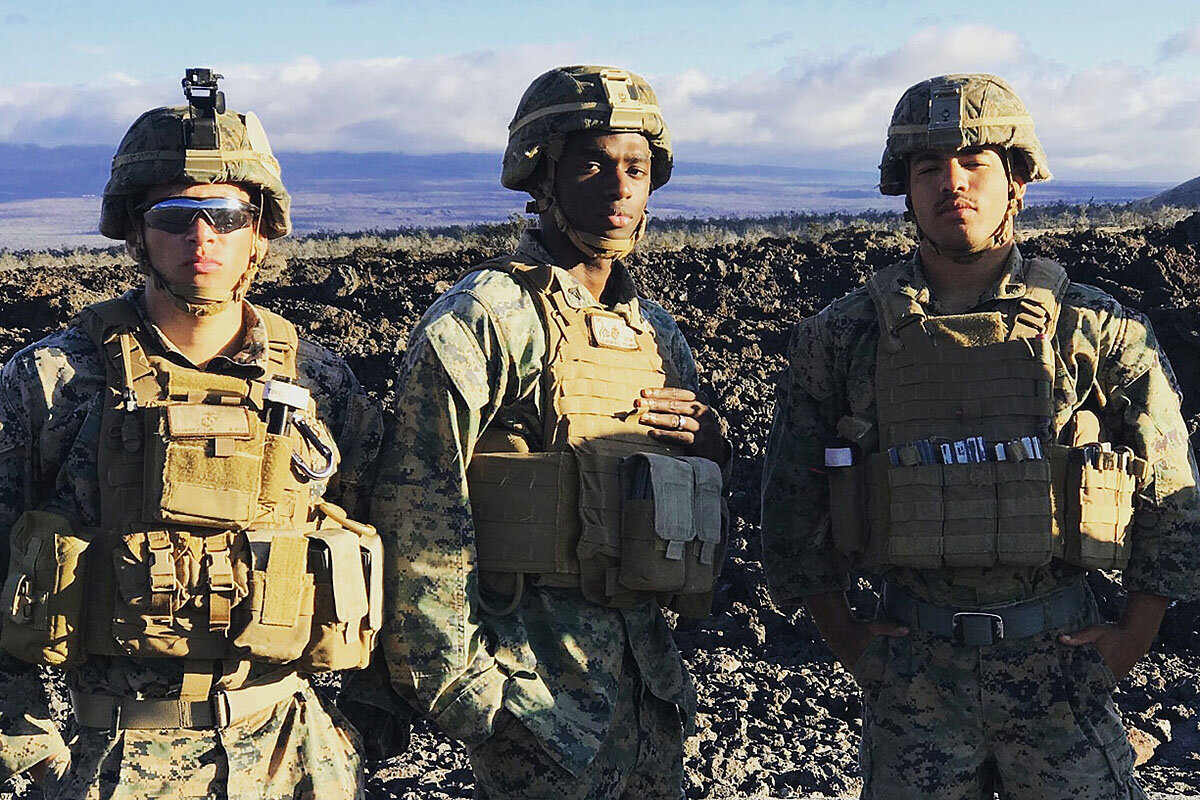
In the past, ideals of respect were rooted in notions of “soulcraft,” or the cultivation of personal virtues that would inform the political policy of “statecraft,” many historians note. The pursuit of narrow interests that benefit a person or particular community is always a powerful force in politics. But respect is a foundation for the stated goals in the preamble to the U.S. Constitution – a conscious effort to form a more perfect union, ensure domestic tranquility, and promote the general welfare.
Respect as democratic glue
Sometimes this kind of respect is modeled in public friendships, like the 1980s ties between House Speaker Tip O’Neill and President Ronald Reagan, who despite being in different political parties shared a deep personal fondness and would call each other to offer congratulations when the other won a bruising legislative battle. The late Supreme Court Justices Antonin Scalia and Ruth Bader Ginsburg, judicial rivals at opposite ends of the spectrum, maintained a deep friendship, a love for opera, and would even vacation together – and then issue scathing critiques of each other’s reasoning in court opinions.
Public gestures, too, play a role in this kind of civic-minded respect. Then-President George W. Bush spoke up for American Muslims after 9/11, noting how the tenets of Islam bring peace and solace to billions. “In our anger and emotion, our fellow Americans must treat each other with respect,” he said in a much-noted speech. Over this past year, some police officers made a simple gesture of respect during protests over the murder of George Floyd, taking a knee amid such civic pain and turmoil.
“Abolitionists from Frederick Douglass to William Lloyd Garrison and Martin Luther King Jr. were civil, but hardly polite,” says Ms. Hudson. “That is because politeness often smooths over important issues when, in the case of slavery and racial segregation, we obviously needed something more.”
“The duty we each have is to learn from these examples in our past, to be aware of this tendency in the human condition, and combat this temptation by sacrificing for our fellow citizens and persons in our everyday,” she says. “It matters for both personal happiness and human flourishing, helping us better get along specifically in a democracy with limited government, in a republic like our own.”
Respect as a tool of oppression
But respect and civility have also been used to oppress and maintain the status quo.
“It’s clear that the concept of civility throughout American history has not been used for the cause of liberation or social justice, but instead for the cause of reactionaries who use it specifically against these causes,” says Alex Zamalin, professor of political science and director of the African American studies program at the University of Detroit Mercy.
Before the Civil War, pro-slavery politicians like Sen. John C. Calhoun of South Carolina denounced the abolitionist movement for fomenting hatred against the South. Their charge: Abolitionists were breaching stabilizing norms of civility and respect.
“This is one of the first times in the 19th century when civility becomes a rhetorical weapon for a political end, and that was not to call for greater inclusion, but to demonize abolitionists as tearing the nation apart,” says Professor Zamalin, author of “Against Civility: The Hidden Racism in Our Obsession With Civility.”
The civil rights movement wrestled with this dual nature of respect.
On one hand, the nonviolent principles of Dr. King were rooted in an explicit and religiously based conception of love that expressed one radical form of respect.
“We must develop and maintain the capacity to forgive,” Dr. King said in one of his sermons. “He who is devoid of the power to forgive is devoid of the power to love. There is some good in the worst of us and some evil in the best of us. When we discover this, we are less prone to hate our enemies.”
Yet when Dr. King was in prison in 1963, charged with violating the ban that Birmingham, Alabama, placed on his protests, he famously wrote an open letter to white clergymen, who were questioning his methods. “He told them the greatest threat to Black freedom is not the klansman; it’s the white moderate who can bask in and use the language of civility while allowing the status quo to continue to dominate and inflict suffering upon people of color,” Professor Zamalin says.
The need to refresh
The need, says political commentator Andrew Sullivan, is for a fresh commitment to the bedrock principles of liberal democracies, including an abiding respect for the inherent dignity and absolute worth of every human being.
“It’s my profound worry about this, that we don’t see each other as individuals,” Mr. Sullivan said during the April panel discussion on civility. “We see each other as avatars of a race or an identity or as something threatening to us, as opposed to another human being.”
“There’s no leavening; there’s no sense that, yes, despite these differences – and they are real, and we have to account for them, and we do understand they’ve affected us – but they’re not the end, and they’re not the only thing and we can transcend them,” he said.
The ideals of respect and civility are important, he and others say, because they naturally root out self-interest and individual entitlement.
Those ideals are yet to be realized for many groups that have been historically marginalized and oppressed. Respect comes in the ability of people of color and others to enter the public sphere and engage in civic debates as their full-throated selves – not compelled to shape their public identities to suit the majority, Dr. West said in the April discussion.
Citing a line from Walt Whitman’s “Democratic Vistas,” he said the goal was for disenfranchised people in America to be able “to stand and start without humiliation, and equal with rest.” And this can have benefits for all.
“That’s the conception of integrity,” he added. “What does it mean to be fully yourself and to bring all of who you are into a public space? Of course you’re going to disagree, of course you’re going to contend, of course you’re going to clash. But you feel as if you can do that in such a way that you can be transformed, and you can transform others.”
“My identity was lost”
It is this sense of integrity that makes mere tolerance insufficient, Mr. Fulghum says.
He enlisted in the Marines thinking it might help him escape the prejudices of the outside world. Yet even as he did this, he worked to erase any hints of the cultural stereotypes often assigned to Black men in American society.
“Near the end of my enlistment, I learned that none of it mattered and my identity was lost,” he wrote in his essay. “I’d tolerated the ignorant rhetoric hoping people would see me as an individual, and not part of a monolith. My idea to change their minds backfired and I spent a year angry at myself. I compromised my identity by depriving myself of things I used to enjoy and changing mannerisms that were unique to me. What’s worse is that I alienated myself from the Black community.”
Today, as an undergraduate studying psychology at Arizona State University, he says notions of tolerance and civility have created classrooms in which students simply mask their deeper selves.
“Schools impede students’ abilities to have those conversations when we make everything this super, super nice environment,” Mr. Fulghum says. “That’s an overcorrection. You need conflict, you need friction, you need vigorous debate and disagreement to make progress.”
Cultivating the ability to have these kinds of conversations is how a much deeper form of respect is forged, he says.
“It can’t be that you go into a conversation with this passiveness, this smile that says, OK, everything’s fine,” he adds. “It’s necessary for students to engage with each other and just as necessary for their emotions to come out, and I think through that we develop an understanding with each other.”

The country is talking about race in schools. Minneapolis offers lessons.
The murder of George Floyd jolted many educators to prioritize teaching about structural racism and social justice – and resulted in pushback over student “indoctrination.” Minneapolis schools offer a window.
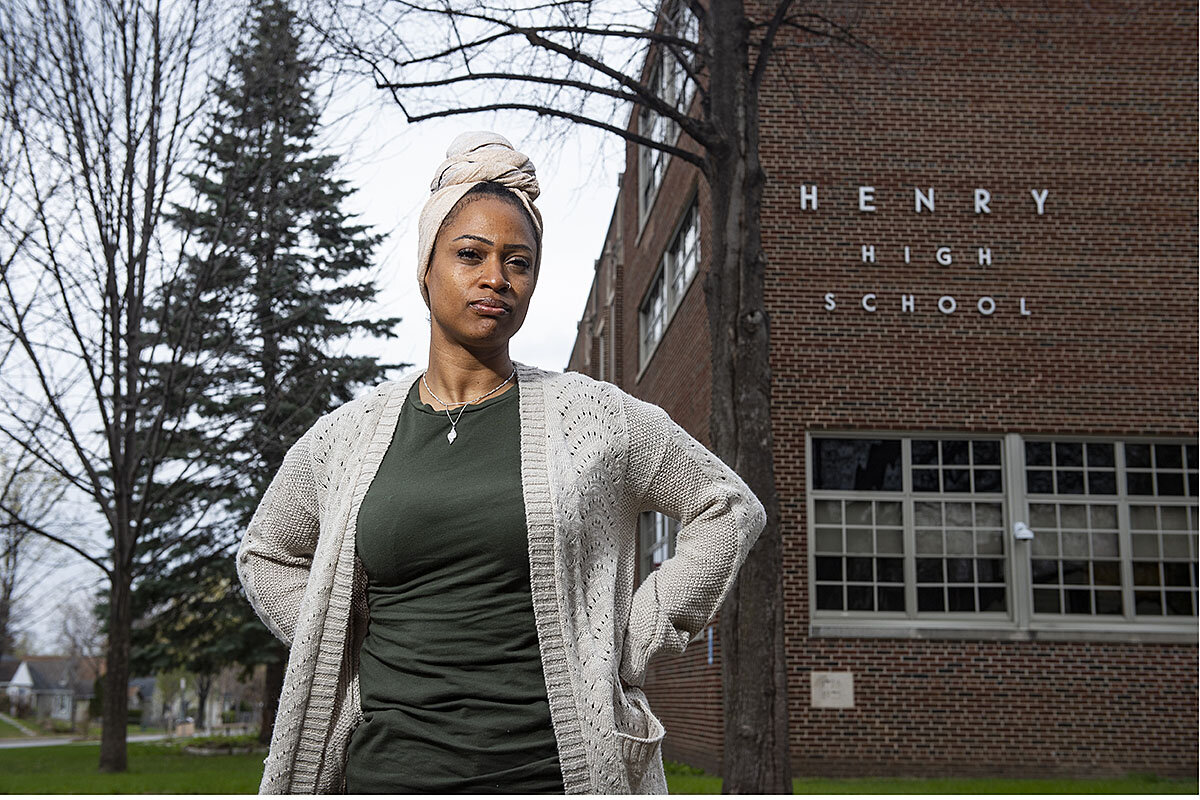
- Quick Read
- Deep Read ( 6 Min. )
Nafeesah Muhammad, a high school teacher in Minneapolis, follows her students’ lead on whether or how much they want to discuss social injustices in the news.
For Ms. Muhammad, covering these topics comes naturally. Some other teachers are uncomfortable or don’t see the purpose. As educators across the country wrestle with addressing the nation’s racial reckoning in their classrooms, what’s happening in Minneapolis offers a microcosm of the struggles and lessons learned since the death of George Floyd here nearly a year ago. It’s played out in the district in the form of teacher training, more space from some teachers for in-class discussion, and, in the Twin Cities region overall, an increase in courses focused on the study of race.
There has been some pushback, as there is with changes being made in the rest of the country. But educators like Ms. Muhammad are trying to be part of the path forward. Her classes include content that shows the strengths and successes of various racial and ethnic groups.
“I believe joy is healing,” she says. “In our classrooms, especially in north Minneapolis, our kids deserve to be in that healing process.”
The country is talking about race in schools. Minneapolis offers lessons.
High school teacher Nafeesah Muhammad decided to play a game recently with her students. In the style of the classic teenage pastime “never have I ever,” she posed statements to her class for discussion. One prompt, “never have I ever been scared of the cops,” resulted in students sharing times when they had felt afraid of the police.
“That opened the door to talk about it, to talk about Daunte Wright, about protests and riots and the National Guard being on their streets,” says Ms. Muhammad, an English teacher at Patrick Henry High School in Minneapolis. “I try to open the window and crack the door and make space for whoever needs to talk about it.”
Incorporating current events into her classroom – and digging deeper to address topics like power, bias, and racism – is something Ms. Muhammad believes is essential in order to connect with her students and help them succeed.
“It recognizes their humanity, it builds community, it builds healing, it allows students to feel seen and allows teachers to learn about what’s going on in their lives,” says Ms. Muhammad, who teaches in a red brick high school surrounded by homes peppered recently with lawn signs reading “Justice for George Floyd” and “Guns Down, Love Up.”
For Ms. Muhammad, who describes herself as a social justice-minded teacher, covering these topics comes naturally, and she’s encouraging her colleagues to move toward a more inclusive curriculum. Some other teachers are uncomfortable or don’t see the purpose. As educators across the country wrestle with addressing the nation’s racial reckoning in their classrooms, what’s happening in Minneapolis offers a microcosm of the struggles and lessons learned since the death of Mr. Floyd here nearly a year ago. It has played out in the district in the form of teacher training, more space in some cases for in-class discussion, and, in the Twin Cities region overall, an increase in courses focused on the study of race.
“These kind of courses have been asked for and rolled out in various forms over the last 15 to 20 years, but you see a higher prioritization, you see more school board members talking about it, you see principals being more open in terms of expressing their desire and creating courses that didn’t exist last year,” says Brian Lozenski, an associate professor of urban and multicultural education at Macalester College in St. Paul.
This echoes a larger debate in the United States about what should be taught in classes – Historic examples of racism? How identity relates to racism? Basic ethnic studies? – and how to create safe environments for such discussions. Addressing journalists this week, Secretary of Education Miguel Cardona said he doesn’t believe the Department of Education should tell local districts what to teach, but he added, “[W]hen students are seen in the curriculum, when they are felt, like their stories are listened to or heard, they are more likely to engage and want to be there.”
Moves to create more inclusive schools for students of color, both in Minneapolis and nationally, have garnered support but also stirred up concerns. Critical race theory, an academic framework that considers how policies and laws perpetuate racism, has emerged as an especially contentious flash point, particularly in conservative circles.
In Idaho, the governor signed a bill on April 28 which states that ideas often found in critical race theory “undermine” the goals of dignity and nondiscrimination in public education. Since April 27, legislators in Oklahoma, Arkansas, and Louisiana have also passed or debated measures related to limiting critical race theory in schools or state agencies. Elsewhere, a school board election in Southlake, Texas, drew an unusually large turnout on May 2, with voters defeating candidates who supported a district plan to make curriculum and disciplinary changes to promote racial and cultural tolerance.
Balancing act
In Minneapolis, there’s momentum from education leaders to build teachers’ skills at addressing racial justice in their classes, both by providing space for informal discussion and with guidance on what should be taught. Minneapolis Public Schools is updating its “climate framework” to create a more welcoming and inclusive culture, is revising its literacy curriculum, and will require an ethnic studies class for graduation starting with the class of 2025. The district did not return requests for comment on how effective these measures have been.
More broadly, in the past year, a handful of school districts in the Twin Cities region have created courses focused on the study of race, says Professor Lozenski. At the state level, the Minnesota Department of Education is reviewing social studies standards, the first draft of which places greater emphasis on the history and culture of historically marginalized groups.
These ideas have been met with some pushback. Katherine Kersten, a senior policy fellow at Center of the American Experiment, a think tank based in Golden Valley, Minnesota, recently criticized the state’s social studies curriculum review, charging that if the draft is approved, “the next generation of Minnesota citizens will not only be uninformed – but scandalously misinformed – about our state’s and nation’s history and democratic institutions. They will, however, be programmed to become the next generation of ‘woke’ social activists.”
By contrast, Professor Lozenski says that creating a more diverse curriculum benefits all students. “Even now, African Americans are often looked at as just being victims of incredible racism, and that’s all people can say about [them],” he says. “It completely ignores the intellectual histories, the artistic exchanges, the mathematics, and the science that [have] been engaged with in these communities.”
“I don’t blame my teachers”
Sonia Svedahl, a senior at Washburn High School in Minneapolis, advocated for an ethnic studies graduation requirement after realizing that she hadn’t learned about her heritage in school. Her mother and grandparents are from India. She says her teachers address current events, but mostly on big news days, and she wishes there was more time for in-depth conversations, through both student-led forums and the course curriculum.
“I don’t blame my teachers because I think everyone doesn’t know what their role in the process is. It’s confusing, you don’t want to do the wrong thing,” she says. She and her friends have led voluntary student discussions at lunch and after school on race-based topics, but they find it hard to draw big groups due to remote learning and the recent transition to in-person classes.
Minneapolis Public Schools started the school year with an all-staff, virtual professional development session about anti-racist education by Dr. Bettina Love, a professor at the University of Georgia and co-founder of the Abolitionist Teaching Network. Nearby districts also offer equity training, but professional development can only go so far, says Lee-Ann Stephens, a former Minnesota teacher of the year who works in the St. Louis Park school district, a suburb adjacent to Minneapolis.
“We offer training quite a bit, especially about creating conversations about race protocols ... but I think it also has to be something that gets internalized and is important. Particularly with race, it’s not normed, it gets uncomfortable because no one wants to offend or say the wrong thing, but students just want us to open a space for them,” says Dr. Stephens.
Statewide, only 4% of teachers in Minnesota identify as teachers of color or American Indian, while 34% of the student population does, according to the Minnesota Department of Education.
Samantha Pree-Stinson, a Minneapolis resident and mom of three sons, says Black students in her neighborhood are “ill equipped to talk about what they’re experiencing” in their personal lives while at school, “and teachers are ill equipped to talk about it.” She advocates for a more diverse workforce and better teacher training, because she believes most teachers “want to be culturally competent.”
“Joy is healing”
Back at Patrick Henry High School, where Ms. Muhammad teaches, a few students linger after school recently, chatting or walking to the baseball fields for practice. One tenth grade student, standing outside with a friend, says she doesn’t like to talk about current events in her classes. “It’s sad to talk about. It’s sad that it keeps happening,” she says, referring to police shootings of Black men.
Ms. Muhammad recognizes that not all of her students want to discuss topics like police shootings or protests in school, and she knows her students need a space to feel joyful. She seeks to provide joy through her classroom environment and with lessons that show the strengths and successes of various racial and ethnic groups. She follows her students’ lead on whether or how much they want to discuss social injustices in the news.
“I believe joy is healing. In our classrooms, especially in north Minneapolis, our kids deserve to be in that healing process,” she says. “Whether covert or overt, I think joy is healing to the students and it creates resiliency in them so they can keep pushing even amid all this craziness.”

‘They changed everything’: A central tension roiling Jerusalem
Jerusalem’s recent riots punctured a facade of calm that obscures deep fault lines. As Jews seek to change the city’s demographics, Palestinians see their cultural and political life suppressed.
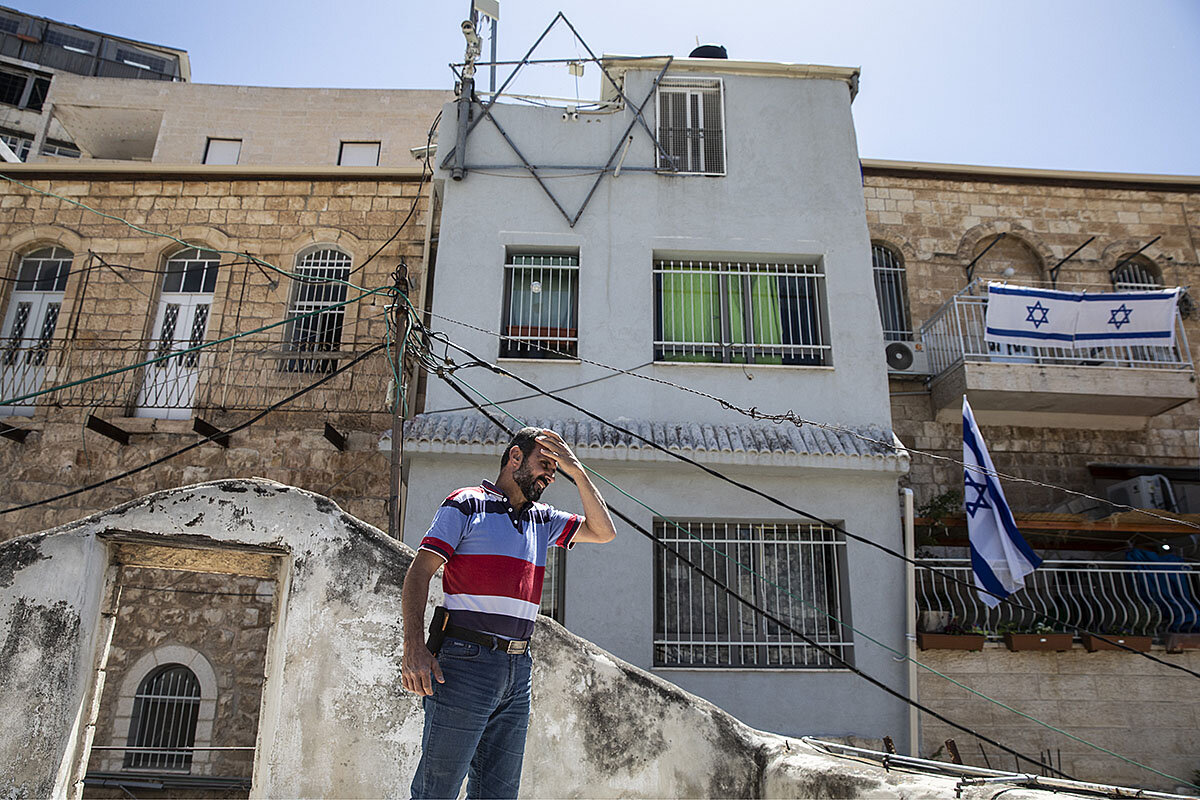
- Quick Read
- Deep Read ( 7 Min. )
-
Fatima Abdulkarim Correspondent
In the East Jerusalem neighborhood of Silwan, outside the Old City’s walls, Jews and Palestinians live in tense proximity. The area is traditionally Arab, but religious Jewish families have bought property and moved in, determined to change the demographics.
Palestinian taxi driver Taha Sarhan lives on the garden level of a house his father built. Two brothers live on the second floor. A third brother sold the top floor to a Jewish group. “I’m mad at my brother, not them,” Mr. Sarhan says, gesturing toward the family upstairs.
Rioting in Jerusalem in late April may have been sparked by a fairly arbitrary Israeli decision to barricade a popular gathering place during Ramadan. But it also reflected deep fault lines. With Israel jealously guarding the symbols of sovereignty, Palestinian cultural and political life has been suppressed.
“Palestinian youth cannot imagine a trajectory that leads them to freedom; that is the ultimate destabilizer,” says Daniel Seidemann, director of a left-wing Israeli nonprofit. “They get by within the two poles of life in East Jerusalem. One is to adapt; the other is to resist.”
Israeli officials say there’s no legal basis for preventing Jews from buying property. Says Arieh King, deputy mayor of Jerusalem: “Jerusalem is the Jews’ only holy city and we have to protect it.”
‘They changed everything’: A central tension roiling Jerusalem
Ibrahim Abbassi walks gingerly between shards of glass on the roof of his home outside the walls of Jerusalem’s Old City – the remains of a pair of solar panels smashed by stones and Molotov cocktails thrown in anger by neighboring Palestinian youths.
Their target was not his home in the Silwan neighborhood of East Jerusalem, but the building across the alley, where Israeli flags fly and upon which is fixed a giant Star of David that glows blue in the night sky.
It’s where several Jewish families now live – an ideological choice they made to live in the heart of a Palestinian neighborhood as part of a long-running and contentious campaign to change the area’s demographics.
Mr. Abbassi, who is Palestinian, feels at times caught in the middle of a dangerous game of chess being played for the fiercely contested city. Once while walking with his children, flying stones missed them by inches. Another time, rubber bullets fired by Israeli forces whizzed through an open window and landed in his then 9-year-old daughter’s bedroom.
“If you get hit or injured there is no one to talk to. If you go to the Palestinians you are seen as a collaborator for blaming them because this is part of a struggle. If you talk to the Israelis, they tell you to tell [the Palestinian youths] not to throw stones,” says Mr. Abbassi, whose complaint to the Israeli police about the rubber bullets was, he says, rebuffed.
One of Mr. Abbassi’s new Jewish neighbors is a woman he first met as a nurse who showed extraordinary compassion tending his mother at the hospital.

After his mother died, when he saw the woman walking by near his home, he mistakenly thought she had come to pay her condolences. But when he saw that she and her children were escorted by the same armed guards who protect Jewish families living in Silwan, he understood she was part of a local Jewish drive for supremacy that has come at the cost of Palestinian families being evicted or displaced.
Indeed, the late April riots in Jerusalem, which punctured a recent facade of relative calm in the city, may have been sparked by a fairly arbitrary Israeli decision to barricade a popular gathering place during Ramadan. But they also sit atop deep fault lines.
With Israel jealously guarding the symbols of its sovereignty over East Jerusalem, Palestinian cultural and political life has been suppressed. Cultural or civic organizations seen as aligned in any way with the Palestinian Authority have been shuttered. Israel says it’s merely enforcing the Oslo peace accord stipulating the PA has no jurisdiction in East Jerusalem.
“If you get up in the morning, take your kids to school, or go to your work, without getting a ticket from a policeman or insulted by anyone on the street, that’s a good day, honestly; you would feel good,” says Mr. Abbassi. “They changed everything in Jerusalem, the buildings, the streets, putting up stones that relate to Jewish history.
“We do not see anything that relates to our culture or heritage anymore, except Al-Aqsa,” he says, referring to the mosque that is the third holiest site in Islam, “because it is the only thing that has remained the same.”
Political aspirations
Another stressor is more purely political. Last week Israeli restrictions on East Jerusalem residents’ participation in Palestinian elections, which require all but a token few to cast ballots in polling places outside the city, were offered as a reason for the PA’s postponing of parliamentary elections scheduled for this month.
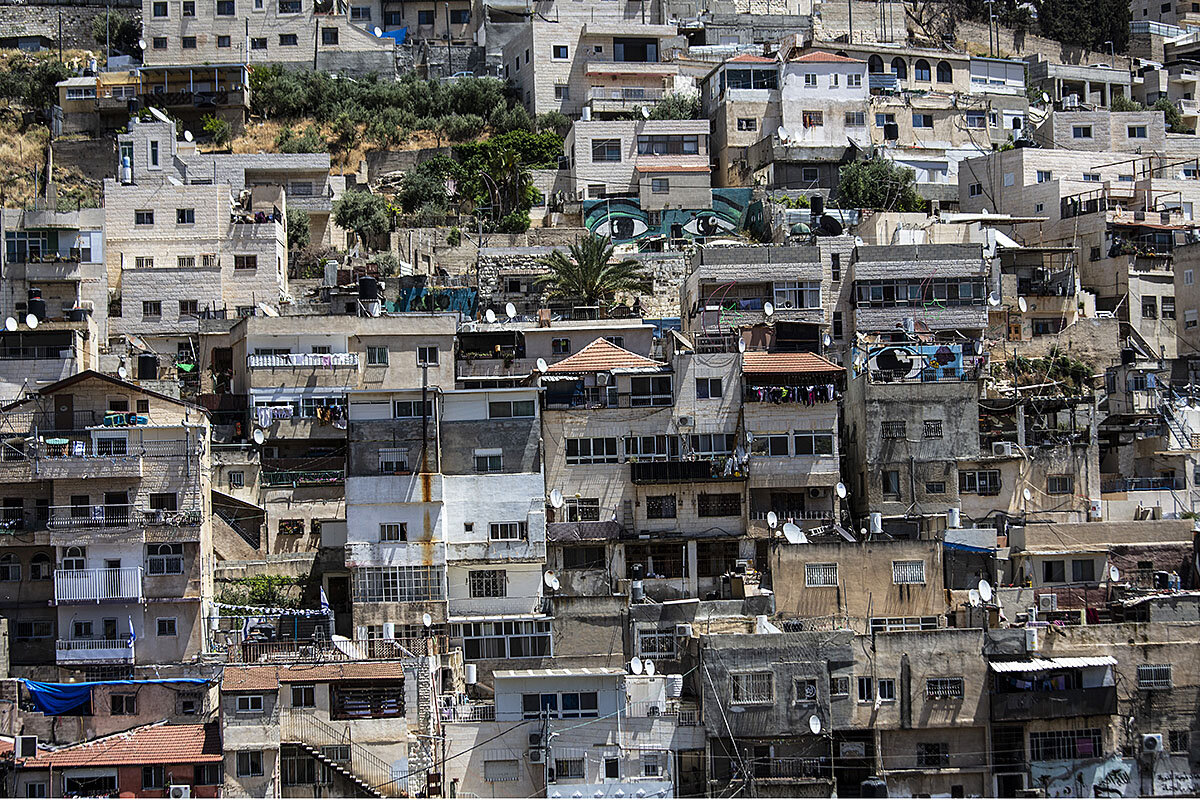
The postponement seemed to add to a feeling of malaise.
“Palestinian youth cannot imagine a trajectory that leads them to freedom; that is the ultimate destabilizer,” says Daniel Seidemann, director of Terrestrial Jerusalem, a left-wing Israeli nonprofit. “They get along; they get by within the two poles of life in East Jerusalem. One is to adapt; the other is to resist.”
Mr. Seidemann says the goal of Jewish groups acquiring properties in traditionally Arab East Jerusalem is to thwart any future attempts to make it into a future Palestinian capital.
But the groups say it’s the historic right of Jews to live anywhere they want to in Jerusalem. Israel captured East Jerusalem from Jordan in the 1967 Mideast war and since then has considered the entire city its united capital. Officials say there’s no legal basis for preventing Jewish Israelis from buying property anywhere in the country.
“We are working to settle them in strategic places to ensure as many Jews as possible are living inside the Old City and near the Old City ... so no one will give it to our enemies,” says Arieh King, deputy mayor of Jerusalem and founder of the Israel Land Fund, which acquires property for Jews in East Jerusalem.
“Jerusalem is the Jews’ only holy city and we have to protect it,” he says.
In local coverage of the recent unrest, an exchange between a young Jewish woman who lives in the Old City and Suleiman Maswadeh, a reporter for an Israeli TV network, went viral. As far-right Jewish marchers shouted racist chants next to them, including a call to burn down Arab villages, Mr. Maswadeh asked the woman her opinion.
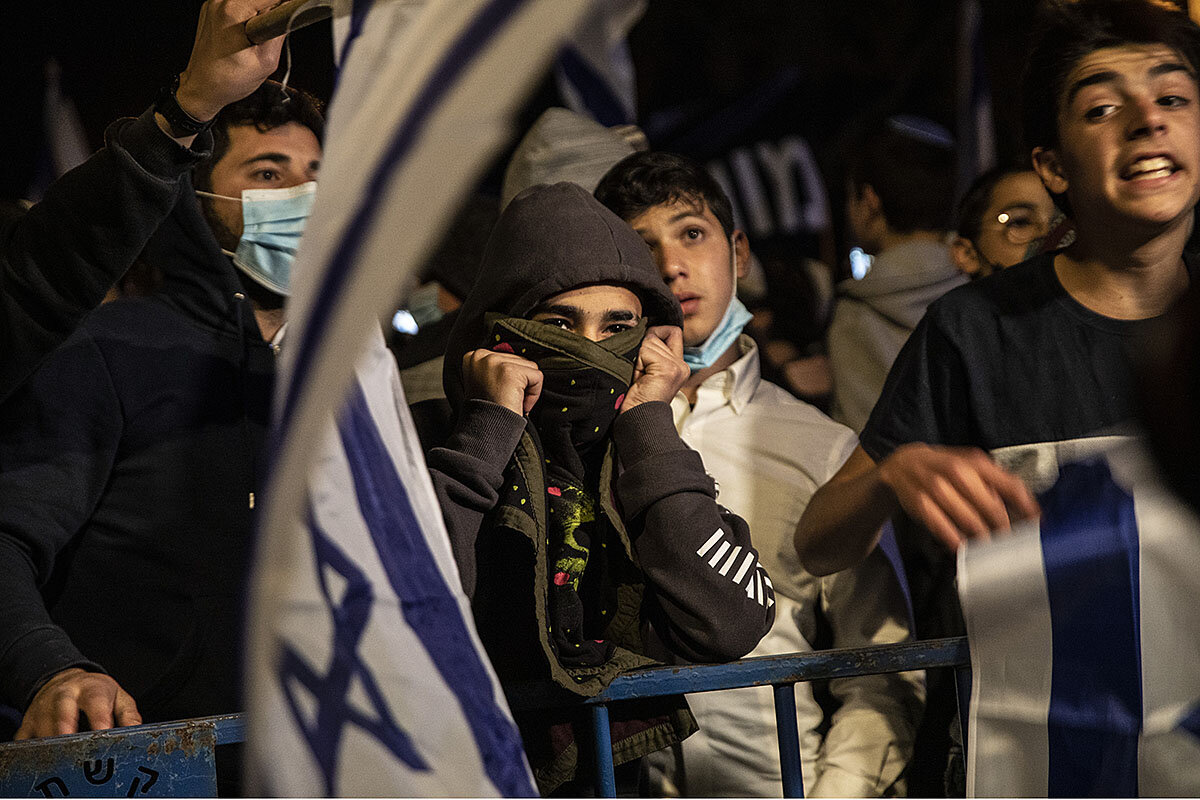
“I’m not saying we’ll burn your village down. I say, ‘Leave the village,’ and then we will come and live in it. That’s what we do in the Old City,” she said.
When Mr. Maswadeh revealed he’s a Palestinian who lives there too, she replied, “Do you want to sell your house?”
Cultural and political organizations
In the past year, several cultural organizations, including one that houses a theater and another that is a prominent music conservatory, were shut down by Israeli authorities, citing tax avoidance and ties to the PA. The organizations denied any wrongdoing.
Orient House, a prominent symbol of Palestinians’ political presence that was shuttered in 2001, remains behind a padlocked gate.
Honaida Ghanim, director of the Palestinian Forum for Israeli Studies, says the situation needs to be viewed as part of Israeli policy since 1967, including “settlements, land seizures, home evictions and demolitions, changing the names of neighborhoods, of streets, and putting border police at their entrances.”
Successive Israeli governments have used these methods, she argues, as part of a long-term vision for a city with no Palestinian presence.
Israeli officials say that’s a lie.
“I categorically deny that there is an Israeli policy plan to turn Palestinians out of East Jerusalem,” a senior government official said.
Turf battles
In Silwan, not far from Mr. Abbassi, Palestinian taxi driver Taha Sarhan lives on the garden level of a house his father built. Two brothers live on the second floor. A third brother sold the top floor to a Jewish group.
“I’m mad at my brother, not them,” Mr. Sarhan says, gesturing toward the family upstairs. “Everything is more difficult these days.”
And getting a haircut at his brother’s barbershop, Alaa Somrein describes living in a Silwan house whose ownership has been contested since he was a boy. “We grew up suffering from the settlers. My father spent most of his life in courts; we lived in fear all our lives. And now our children are in the same situation.”
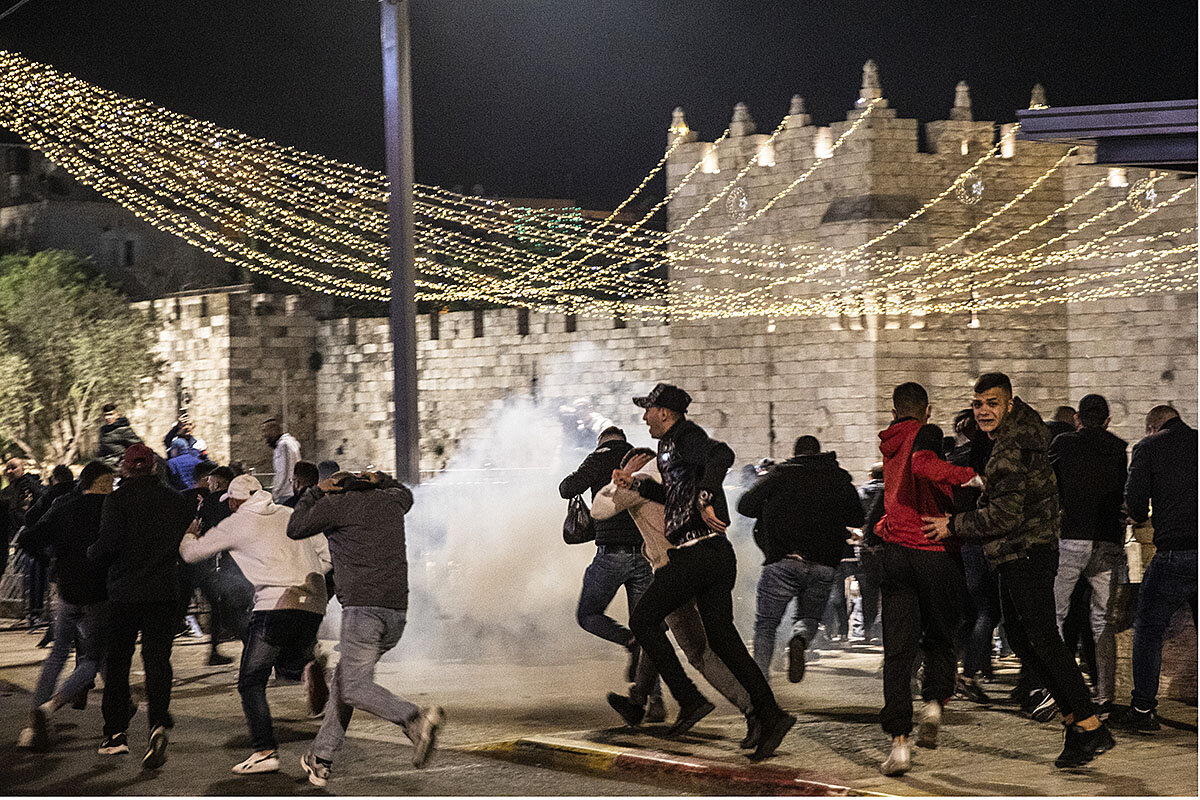
North of the Old City, anxiety is rising over Jewish settlement in the Sheikh Jarrah neighborhood.
On Saturday, a group of about 50 young demonstrators gathered under a sprawling fig tree to protest eviction orders regarding four families. On Thursday, an Israeli Supreme Court judge is expected to rule whether those families have a right to appeal the orders.
At issue are 27 houses built in the 1950s by the United Nations and the Jordanian government for Palestinian refugees. A Jewish organization later claimed ownership of the land based on Ottoman-era documents.
Eyal Raz, a Jewish activist trying to prevent eviction, says two Israeli laws are at play: One negates Palestinian rights to property owned before the 1948 Mideast war that led to Israel’s creation; another protects pre-1948 Jewish property in Jerusalem.
“The legal infrastructure is discriminatory. That’s a fact,” he says.
Watching the demonstrators was Maryam Ghawi. She was evicted from her house in Sheikh Jarrah in 2009. Every day she returns to sit next to it, even though it’s now inhabited by a Jewish family.
“Four generations lived here, in this very house,” she says, referring to a home now festooned in Israeli flags and covered in security cameras. At one point, a protester unfurled a Palestinian flag, reached over a metal fence, and waved it across the courtyard.

Essay
Reporter’s notebook: How MLK’s dream inspires one Chinatown resident
Sometimes an event moves a supporting character onto center stage. That happened recently to someone our reporter had interviewed, and it shined a light on his heart and humanity.

- Quick Read
- Deep Read ( 4 Min. )
In a windowless room at the Oakland Asian Cultural Center, Carl Chan unspooled his story, focusing on two foundational events that, he says, “changed my life.”
The first occurred as a middle school boy in British-governed Hong Kong, where he was born in 1958. As he walked to catch his bus home, he noticed five white British boys picking on a Hong Kong boy. “This is wrong! Don’t pick on him!” he told the boys.
Surely, he thought, if he spoke up, people around him would stand with him. Instead, the Hong Kong boy ran away, and the British boys turned on him, beating him. And to his great surprise, bystanders told him not to fight back.
Years later, in the United States, he saw a video featuring a Black man giving a speech. “The energy!” he says. “‘I have a dream.’ That was so powerful.”
Mr. Chan says he felt as if Martin Luther King Jr. was almost telling his own life story, inspiring him to do his best to make positive change.
So he persists, despite recently being attacked in what police say was a hate crime. He sometimes has nightmares. But if anything, his resolve is stronger.
Reporter’s notebook: How MLK’s dream inspires one Chinatown resident
When reporters go on trips to dig into a subject, they return with notebooks full of stories. For any number of reasons, some good ones live the rest of their lives sealed between the cardboard covers of those notebooks, stored in a drawer until they are finally thrown out.
So it was with the backstory of Carl Chan. I spent well over an hour interviewing him for my recent cover story on the extraordinary grassroots effort in Oakland, California, to fight Asian hate in that city’s Chinatown. As president of the Chinatown Chamber of Commerce, Mr. Chan is in the thick of it, organizing rallies, raising money for security cameras, and fielding the chamber’s volunteer street patrol to protect seniors and others from physical and verbal attacks. He appeared prominently in my article, but his life-changing personal history went unused.
Until today. Because now this big-hearted man has become a story himself. On April 29, in broad daylight, Mr. Chan was punched in the head from behind and knocked to the sidewalk, his attacker yelling profanities and racial slurs. Mr. Chan, who was on his way to visit another assault victim, mustered the wherewithal to photograph his attacker and share the images with police. After police arrived, he spotted the attacker and ran after him, with police also in pursuit. Officers arrested the suspect, a 25-year-old, who was out on parole. He has since been charged with assault and battery, a hate crime, and parole violation.
I sent Mr. Chan a text of empathy and encouragement when I read about the incident on Monday. He texted back that he is “overwhelmed with the love and support.” He has received more than 10,000 messages, including texts, emails, letters, flowers, and calls from elected officials, law enforcement officials, religious leaders, reporters, friends, family, and people he doesn’t even know “from all over the world of all communities.”
Mr. Chan doesn’t know the suspect. He also doesn’t know the motive. And that takes me to his backstory.
Because statistics on hate crimes and aggressions against members of the Asian community are inconclusive, I wanted to gather anecdotal evidence during my March visit in Oakland to fill out the picture. I systematically asked people I interviewed whether they had ever had encounters with racism – during the pandemic or in their more distant past. Almost everyone had. When I asked Mr. Chan, he stopped to compose himself. Only one other reporter has ever asked him about this, he said. “Every time I talk, I try to hold my tears.”
And so in a windowless, gray conference room at the Oakland Asian Cultural Center in the heart of Chinatown, Mr. Chan unspooled his story of pain and promise, focusing on two foundational events that, he says, “changed my life.”
The first occurred as a middle school boy in British-governed Hong Kong, where he was born in 1958. It was summer, so the school kids were wearing white uniforms. As he crossed through a park to catch his bus home, he noticed five white British boys picking on a Hong Kong boy. “This is wrong! Don’t pick on him!” he told the boys.
Surely, he thought, if he spoke up, people around him would stand with him. But the Hong Kong boy ran away, and the British boys turned on him, calling him “Chinese pig,” repeatedly beating him, and standing on him. Each time he was thrown down, he stood up, but the beating continued until his uniform turned red and the boys lost interest. To his great surprise, bystanders were telling him not to fight back.
“When I was hearing my own people ridiculing me, saying, ‘You are stupid! You should just stay down,’ that’s when I was crying so bad.” He was not mad that he stuck up for the boy, “but I was so upset, unhappy, when I’m seeing my own people just stand and watch.”
When he got home, his mother was upset by what had happened to him – and also because public fighting could get him expelled. And surely, if the police had come, he would have been the one jailed, not the white boys. The next day, he received a stern lecture from a school official, with frank talk of expulsion. But when the student told his story, the official backed down, saying, “Next time, when you fight, I want you to win. Go home.”
And so he did. Eventually to a new home in the United States, where he and his mother and siblings legally joined his sister in California. Mr. Chan enrolled in Oakland Technical High School, where, for the first time in his life, he saw a video. It featured a Black man giving a speech.
“I had no clue who he was. I understood part of it. And I could feel most of it. The energy! Oh my gosh. Someone was talking to me. ‘I have a dream.’ That was so powerful.”
Mr. Chan says he felt as if Martin Luther King Jr. was almost telling his own life story. Dr. King was not speaking only to the Black community, but to the world, and this inspired the young Mr. Chan to do his best to make positive change.
And so he persists. Since the pandemic began, Mr. Chan has endured looks and name calling too numerous to mention. He sometimes has nightmares. But if anything, his resolve is stronger, and in his text, he said he was working to organize the May 15 Unity Against Hate rally in cities across America, including in Oakland.
“I am so proud of us standing together to fight the racial attacks against our community,” he texted. He signed off with a red heart emoji.

Points of Progress
Help for birds to bees, from 3D-printed beaks to bug superhighways
In our global progress roundup, intense efforts by volunteers as well as scientists are protecting animal life, from vulnerable turtles nesting in Cyprus to pollinators that need more habitats in the U.K.
Help for birds to bees, from 3D-printed beaks to bug superhighways
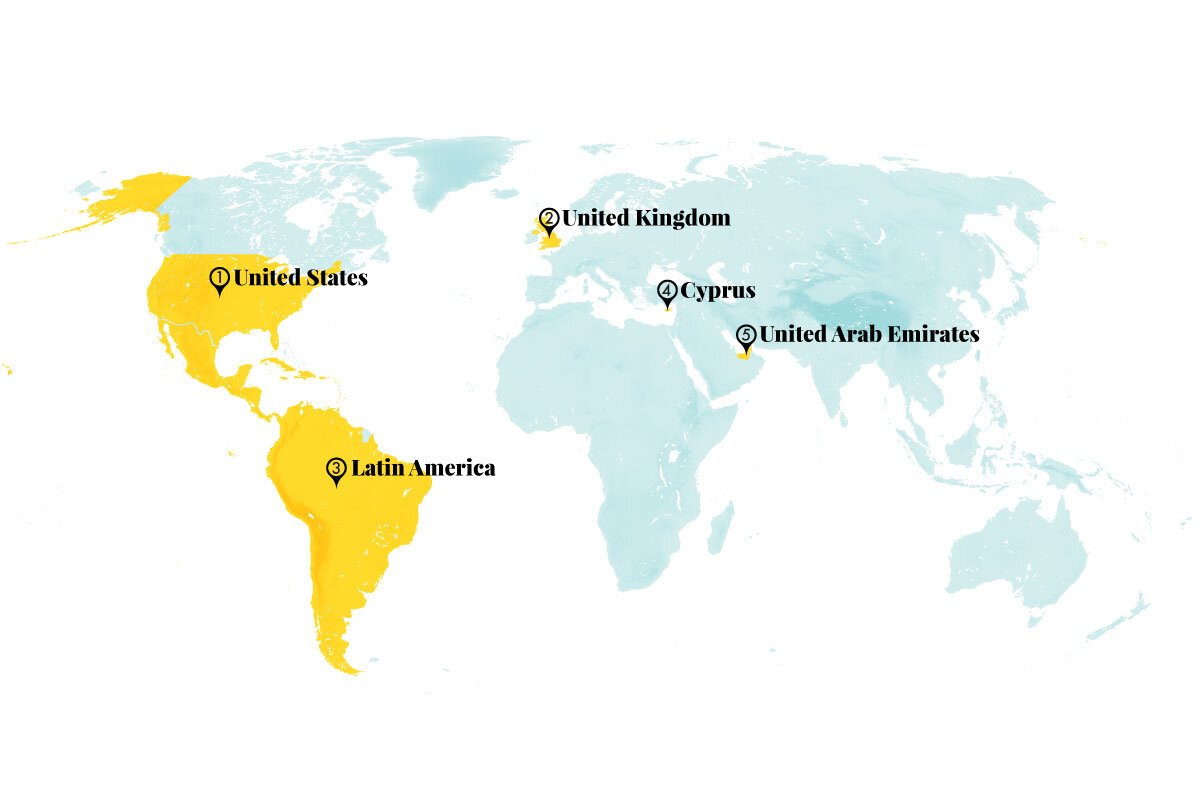
This week in good news, a surprise decline in suicides in the United States, new private equity funding for gender equality in Latin America, and a new lease on life for animals around the world thanks to 3D printing.
1. United States
The suicide rate in the United States reached a five-year low in 2020, defying predictions that self-harm would rise during lockdowns. Instead, a preliminary report from the Centers for Disease Control and Prevention shows deaths by suicide fell to 44,834 last year, a 5.6% decrease from 2019 figures. This is the second consecutive annual decline, and marks the lowest suicide rate since 2015.
Some data – including demographic breakdowns – is not yet available, and experts are still trying to determine the reasons behind the dramatic decline. Some say that the early “heroism phase” of the pandemic, in which people banded together to share messages of support, could have played a role, as well as the continuation of 2019 suicide prevention initiatives and access to remote health services.
If you are in crisis, please call the National Suicide Prevention Lifeline at 1-800-273-TALK (8255).
The Christian Science Monitor, The Associated Press

2. United Kingdom
A U.K. charity has launched an initiative to restore more than 370,000 acres of flower-packed habitats and create a national network of insect superhighways. B-Lines, a pollinator connectivity project by Buglife, has been years in the making, with successful pilots in several areas including Cardiff, Wales. Coordinators spent a decade mapping the best routes between fractured insect habitats, and with that information, they may now team up with residents, businesses, conservation groups, and local authorities to help bring back Britain’s wildflower meadows and make this network a reality. Pollinator insects, such as honeybees, bumblebees, and butterflies, play a vital role in maintaining a healthy ecosystem.
“Off the back of [the launch] we have had housebuilders ringing up asking how they can incorporate the network into housebuilding,” said Paul Hetherington, director of fundraising and communications at Buglife. “The things that have really hammered pollinators, and bugs in general, are habitat loss, fragmentation of habitat, loss of connectivity of habitat, climate change and pesticides – this deals with everything except pesticides.”
Euroweekly News, Buglife
3. Latin America
Investors in Latin America are increasingly focusing on gender diversity, according to experts from the International Finance Corp. As a result of workplace sexism, social pressures, and family responsibilities, many women struggle to enter and remain in the workforce. In emerging economies, private equity funds can play a special role in promoting positive change. The Central American Small and Medium Enterprise Investment Fund (CASEIF), for example, has supported 33 businesses and created more than 10,000 jobs over the past two decades – more than 40% of those positions have been filled by women.
At one CASEIF-owned company, Paradise Ingredients, women make up the majority of the management team. They achieved this in part by offering free health care and providing school supplies to single mothers who work for the company. “Here, people respect you for your capabilities,” said Tannia Leiva, production manager at Paradise Ingredients. “We are a big company and we are setting the standard.”
International Finance Corp.
4. Cyprus
Important Mediterranean turtle populations are rebounding in north Cyprus following a decadeslong effort to protect nesting habitats. Founded by conservation enthusiasts in the early 1980s, the North Cyprus Society for the Protection of Turtles (SPOT) has overseen the revival of green and loggerhead turtles. During last year’s six-month nesting season, volunteer patrol teams counted more than 2,400 nests – an all-time high. Since 1993, green turtle nests have increased by 162%, and loggerhead turtle nests are up 46%.
Conservationists credit their success to SPOT’s early volunteer program, which raised residents’ awareness of the turtles; the local government, which embraced a protective agenda and limited tourism development on several beaches; and the steady stream of international volunteers who pay to participate in conservation work, from nest surveys to beach cleanups.
Mongabay
5. United Arab Emirates
The United Arab Emirates has named the first Arab woman to train as an astronaut. The Mohammed Bin Rashid Space Centre chose Nora al-Matrooshi, a mechanical engineering graduate who works for the National Petroleum Construction Co., along with Mohammad al-Mulla, to join the Gulf nation’s growing astronaut program. She was one of 4,300 applicants who were judged on their education, relevant experience, scientific abilities, and physical assessments. The new recruits will go to NASA’s Johnson Space Center in Texas to receive training.

Ms. Matrooshi called the announcement an “unforgettable moment” and said she’s drawn inspiration from Hazzaa Al-Mansoori, who became the first Emirati in space in 2019 when he spent eight days on the International Space Station. “I aim to work hard to script historical moments and achievements that will be etched forever in the memory of our people,” she said on Twitter.
Reuters, ABC News
World
As experience with and access to 3D-printing technology grows, so do prosthetics options for injured wildlife. Creating animal prosthetics has historically been an expensive and time-consuming endeavor – in the early 2000s, it could take $100,000 and more than a year to create an artificial dolphin flipper – but dedicated keepers are now using printers to make these custom pieces more efficiently. Designers can easily adjust their models on computer software to bring their vision to life.

This technology has been used many times on birds to replace amputated legs and broken beaks, and often these prosthetics are lifesaving. There are some challenges – some beak prosthetics fail when even a slight growth spurt pushes the mold out of place, and heavier creatures such as elephants won’t be able to use printed prosthetics until the printing material becomes more durable.
Mongabay
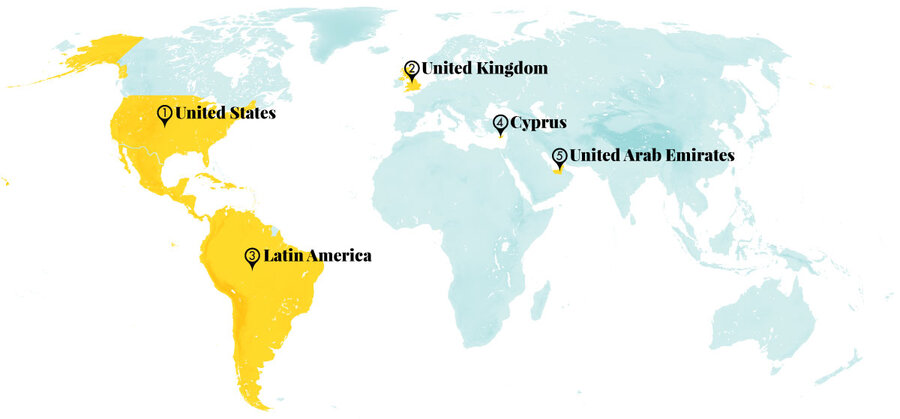
Other headline stories we’re watching
(Get live updates throughout the day.)The Monitor's View
Why the US extends the long arm of law
- Quick Read
- Deep Read ( 3 Min. )
-
By the Monitor's Editorial Board
During a visit to Ukraine this week, U.S. Secretary of State Antony Blinken plans to deal with what he calls the “internal threat” to Ukraine – the vast corruption that undermines its democracy. Meanwhile, Vice President Kamala Harris, assigned to curb immigration from Central America, faces a crisis of corruption in El Salvador after a judicial coup by its president.
These events illustrate how much the United States leads the world in battling corruption and encouraging people in other nations to demand equality before the law and an end to impunity. For decades, its most effective tool has been the 1977 Foreign Corrupt Practices Act. The U.S share of global anti-corruption enforcement actions is now 66%.
The long arm of U.S. law, along with pressure on countries to reform, touches a universal desire for honesty. Steadily, the U.S. can set a new world norm.
Why the US extends the long arm of law
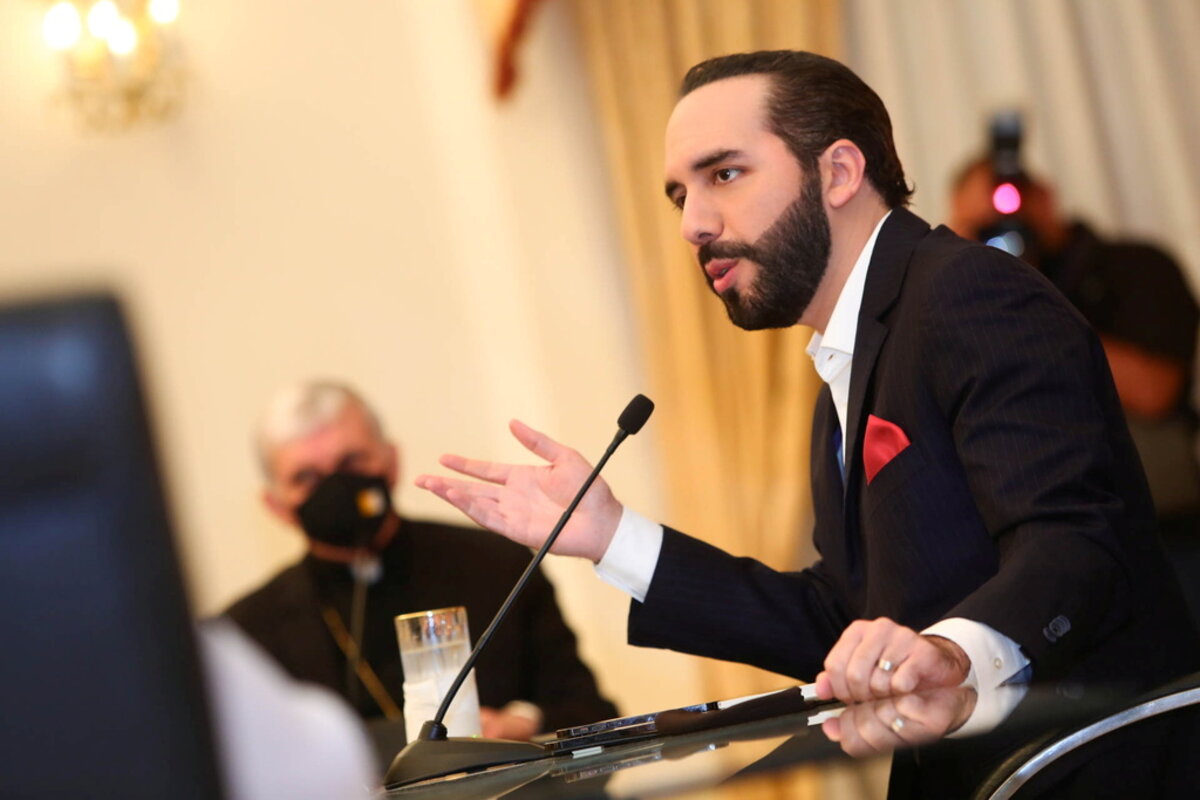
During a visit to Ukraine this week, U.S. Secretary of State Antony Blinken will no doubt deal with Russia’s military threat to its neighbor. Yet the top American diplomat may be more focused on what he often calls the “internal threat” to Ukraine – the vast corruption that undermines its democracy.
The United States has long used its extraterritorial powers to influence Ukraine’s anti-graft direction. It has imposed sanctions on Ukrainian oligarchs and leaned on the International Monetary Fund to withhold a $5 billion loan. Now the Biden administration wants to ensure Ukraine, which seeks to become a U.S. ally, finally adopts honest governance under President Volodymyr Zelenskiy.
“We’ve stressed for many years in our efforts to help Ukraine that the key reforms in terms of transparency, in terms of fighting corruption, are what will be most important to Ukraine’s stability and future progress,” says acting U.S. Assistant Secretary Philip Reeker for the Bureau of European and Eurasian Affairs.
The Biden administration faces a similar task in Central America. Just five weeks after the president assigned Vice President Kamala Harris to reduce immigration from the region, she faces a crisis of corruption in El Salvador.
On May 1, President Nayib Bukele and his ruling party in the legislature removed all five justices of the constitutional chamber of the Supreme Court. The move was widely seen as a way to block anti-corruption investigations of top officials. Ms. Harris said the U.S. “must respond” to this judicial coup, although she did not say how.
President Joe Biden has promised to invest $4 billion in Central America. Yet, said Ms. Harris, “We will not make significant progress if corruption in the region persists. If corruption persists, history has told us it will be one step forward and two steps back. We know corruption causes government institutions to collapse from within, preventing people from getting their children educated, from getting a business started, from getting a fair trial.”
These events in Ukraine and El Salvador illustrate how much the U.S. leads the world in battling corruption and encouraging people in other nations to demand equality before the law and an end to impunity. For decades, its most effective tool has been the 1977 Foreign Corrupt Practices Act, or FCPA. The law targets companies with a U.S. presence that engage in bribery. It also provides a strong incentive for American companies to keep their hands clean overseas.
The number of prosecutions under FCPA has risen in recent years. And the law’s success inspired the United Kingdom to pass a similar measure in 2010. The U.S. has worked with more than a dozen countries in prosecuting cases. Its share of global anti-corruption enforcement actions is 66%, according to Trace, a business association dedicated to good governance.
“The fact that more countries are opening more investigations into possible transnational bribery occurring within their own borders is a promising sign that enforcement authorities globally are building investigative capacity and taking anti-corruption seriously,” says Trace President Alexandra Wrage.
FCPA’s greatest impact may be in ensuring American companies set a good example – which can give them a competitive advantage in winning foreign contracts. “I’ve seen countries say, ‘We’re going to use an American company to build this road because we know that that contract was not obtained through illicit means,’” says Jose Fernandez, a Biden nominee to become an undersecretary of state.
The long arm of U.S. law, along with pressure on countries to reform, touches a universal desire for honesty. Steadily, the U.S. can set a new world norm.

A Christian Science Perspective
Each weekday, the Monitor includes one clearly labeled religious article offering spiritual insight on contemporary issues, including the news. The publication – in its various forms – is produced for anyone who cares about the progress of the human endeavor around the world and seeks news reported with compassion, intelligence, and an essentially constructive lens. For many, that caring has religious roots. For many, it does not. The Monitor has always embraced both audiences. The Monitor is owned by a church – The First Church of Christ, Scientist, in Boston – whose founder was concerned with both the state of the world and the quality of available news.
Children of light
- Quick Read
- Read or Listen ( 3 Min. )
A spiritual understanding of what we are leaves no room for conflict or division based on our uniqueness.
Children of light
The author’s name has been withheld at their request.
Recent headlines have brought up memories of my own experiences with racism. This includes being unable to find a rental house in a college town, being slugged by a passerby on a street in another city apparently due to my minority color, and once being vehemently told that people with my skin color were “the enemy.” The memories were disturbing and caused me to ask aloud, “When will it ever end?”
A somewhat surprising answer came immediately: when we realize we’re all children of light and that the colors of the rainbow aren’t at odds. The green band isn’t fighting the violet; the red doesn’t conflict with the blue. Each apparent color is part of the same clear beam of light, showing its unique wavelength as the light passes through water droplets on its way to our field of vision.
I pulled out a copy of the Bible to find the reference I recalled about “children of light,” and found the Apostle Paul saying: “For ye were sometimes darkness, but now are ye light in the Lord: walk as children of light” (Ephesians 5:8).
It reminded me that, even when experiencing color prejudices, I’d seen solutions through prayer, through lifting thought to God. Shifting thought from the “darkness,” or a limited view of ourselves as material beings of various human ancestries, to the “light” of God’s allness and the truth of what we are as God’s spiritual offspring, brings our common bond into clearer view. Realizing a bit more of our spiritual identity, created and forever sustained by our common source, Spirit (a biblical term for God), enables us to live or “walk as children of light.”
Following the rainbow analogy a bit further, I laughed to realize that we would never see the colors vying for different or wider bands, or fearing that another color would overrun them. An image of the colors fighting to hold their places in the beautiful arc seems silly when we know that they’re all of and sustained by the same beam of sunlight. Translating this analogy to our human scene can help us see that we don’t have to fear or fight, because all have a harmonious place in God’s creation.
I recalled, for example, that years back when my interracial family was blocked from renting available larger homes in our small city one mid-winter, we found a home in another city. The move blessed us and also blessed an interracial couple who had just arrived from a distant country to attend graduate school, and was grateful to take over our old lease.
As for the random slug and racist remark, while our responses to these kinds of situations may necessitate different actions at different times, I recalled that in both instances I’d quickly been able to move forward, that those incidents didn’t hold me back. Through my prayers at the time I had realized that the incidents were due to that darkness of thought, and that these individuals had simply yet to realize our common bond – a spiritual fact we are all equipped to realize.
I also remembered a statement from the Monitor’s founder, Mary Baker Eddy. Her words helped me then, and can help us now, to solve the fractious problems of the material scene by lifting thought and our communities into the light of God’s oneness:
“One infinite God, good, unifies men and nations; constitutes the brotherhood of man; ends wars; fulfils the Scripture, ‘Love thy neighbor as thyself;’ annihilates pagan and Christian idolatry, – whatever is wrong in social, civil, criminal, political, and religious codes; equalizes the sexes; annuls the curse on man, and leaves nothing that can sin, suffer, be punished or destroyed” (“Science and Health with Key to the Scriptures,” p. 340).

A message of love
Triumph in a laundry cart
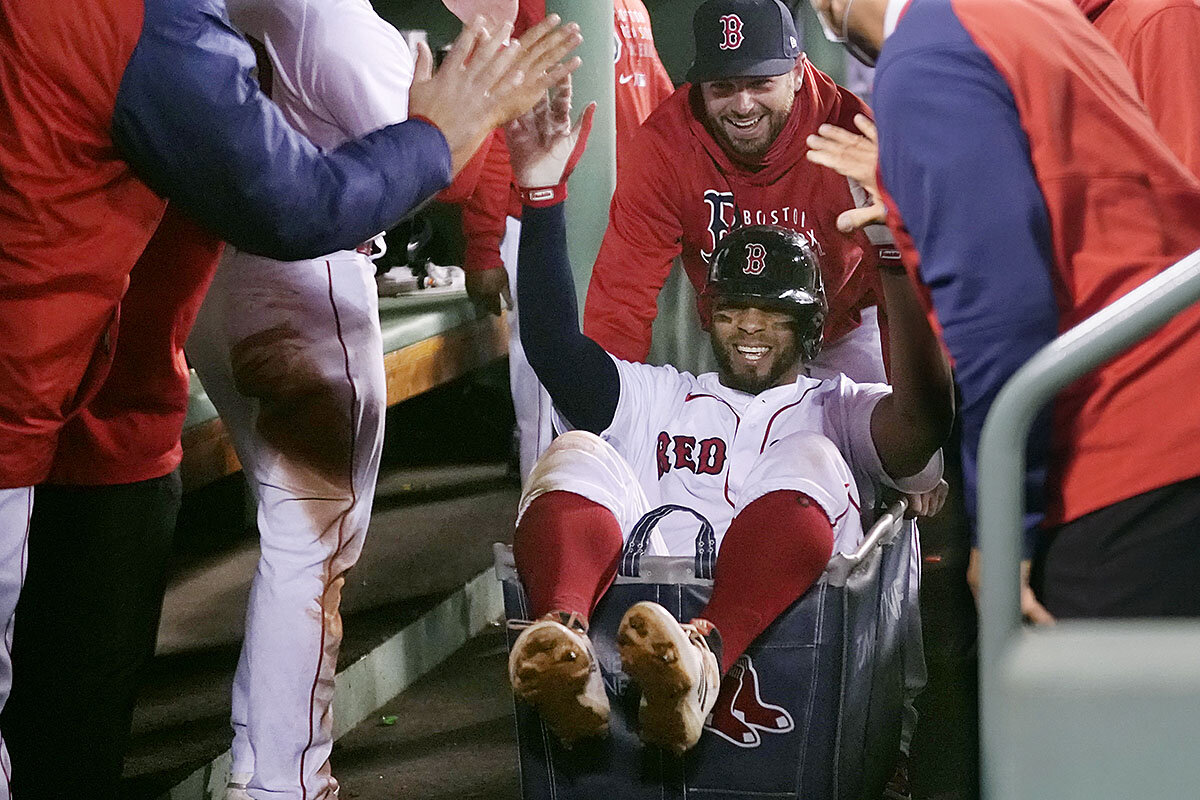
A look ahead
Thank you for joining us today. Please come back tomorrow when we look at how the pandemic has affected universities’ efforts to bring in students of all backgrounds – and what universities are doing to push forward.


